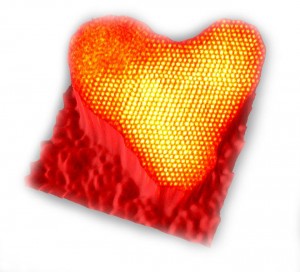Marimar informed me with a sly grin, that he sent me a Valentine today. He keeps track of all the new sciences & technologies that seem to be pouring forth now into our new universe. so I was delighted when I saw it:
The World’s Smallest Spontaneous Atomic Valentine
February 14, 2010 by Ted Goodman
The Jeol 2100F microscope, a new generation aberration-corrected electron microscope, allows a clear view of the palladium atoms.
PhysOrg.com) — Palladium atoms placed on a carbon base spontaneously formed into an 8 nanometer heart at the University of Birmingham’s Nanoscale Physics Research Laboratory this week. Just in time for Valentine’s Day!
According to the physicists observing the atoms through the Lab’s JEOL 2100F microscope, Zhiwei Wang and David Pearmain, they watched with love, but really had absolutely nothing to do with the heart formation of the atoms.
Saleena’s Note: This a time when the mysteries of life are unfolding daily in startling and delightful ways to revel so much more about our reality to us. Within the Parapsychology realm there have been experiments created that show that the intentions or expectations of a researcher can & does influence different results when they are a part of an experiment that gives each participant the indentical conditions for a test. The results of their experiments turn out in a variety of ways. Also the research of Dr Masaru Emoto shows the responsiveness of the element of water; water crystals are influenced by our thoughts & words. I suggest that there is much we are about to discover about our deeper interconnectedness with life. There is a possibility that this tiny little elemental atomic expression could be an intelligent display; a message of love from these elements to us.
Continue the arcticle: Sadly, the bright, beautiful palladium Valentine will not be given to a special lady. Being only 8 nanometers in size, it can’t be seen by the human eye, and cannot even be relied upon to stay in the smallest ring setting. But we can all admire the wonderful high-angle, very high-power shot of the world’s smallest and, arguably, prettiest naturally-formed Valentine.
Although the palladium Valentine was a nice surprise for the scientists, they actually have other reasons for studying the palladium atoms. Professor Richard Palmer, head of the Laboratory explained:
“Size-selected atomic clusters, of the kind which fused together to assemble the atomic heart, are of practical relevance as model catalysts; the palladium/carbon system is employed as a real industrial catalyst in the fine chemicals sector. Precise control of the atomic architecture of the clusters may lead to enhanced yield and especially selectivity in complex catalytic reactions, as well as reducing the number of metal atoms needed to catalyze the reaction.”
The Nanoscale Physics Research Laboratory was established in 1994 as the first centre for nanoscience in the UK. Four spin-off companies have been generated from the Laboratory since 2005.
More information: Information provided by: Professor Richard Palmer, The Nanoscale Physics Research Laboratory, University of Birmingham.
© 2010 PhysOrg.com







